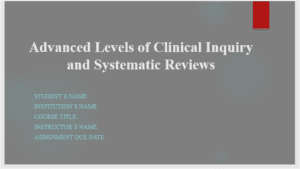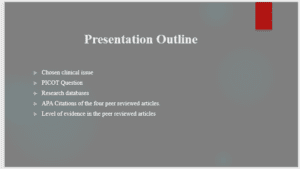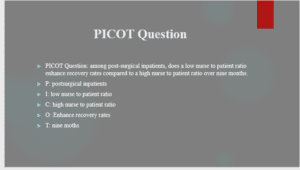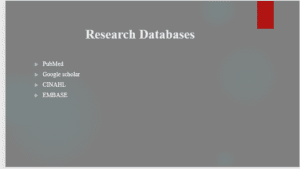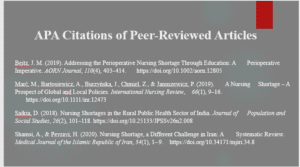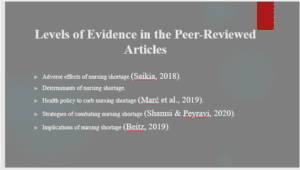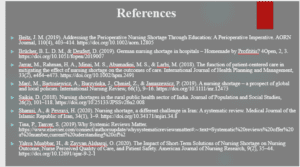Advanced Levels of Clinical Inquiry and Systematic Reviews
Do you need urgent assignment help ? Our homework help will you tons of energy and time required for your homework papers.
Hello and welcome to today’s presentation on advanced levels of clinical inquiry and systemic reviews. This presentation has been designed to provide information about the clinical issue. Furthermore, research databases, systemic reviews (research articles), and PICOT question formulation will be discussed.
We will begin by discussing the chosen clinical issue. We will then evaluate the formulation of my PICOT question. We will then identify the research databases used. Thereafter, we will provide APA citations of the peer-reviewed articles. Finally, we will explore the evidence provided by the research articles.
According to the World Health Organization data, a shortage of approximately 7.2 million health workers will occur by the year 2025. This will affect service delivery in the hospital setting. Furthermore, the demand for nursing personnel will spike to about 12.9 million (Muabbar & Alsharqi, 2020). Nursing shortages negatively affect different factors, including the provision of health care services, quality of service delivery, the amount of work done, and the physical and mental well-being of the nurses. This leads to delays in recovery, prolonged hospital stays and negative financial implications (Jarrar et al., 2018). There are many factors affecting the healthcare system due to the nursing workforce shortage. They include a diminished quantity of student nurse enrolments and an increasing number of early retirements related to underlying health issues (Brücher & Deufert, 2019). The inadequacy of policies and poor planning of the workforce are the main etiological factors of the nursing shortage worldwide.
PICOT question entails research elements of a clinical question. It aims to identify the patient or population, intervention or indicator, comparison or control, outcome, and finally, the time or type of study or question. The PICOT question formulation should consider a case scenario. An answer to the case scenario should be provided in the PICOT Question. The PICOT question can be Preventive, diagnostic, etiological, or prognostic in nature. I ensured that the clinical issue was incorporated when developing my PICOT question. It was used to compare the PICOT questions. A high nurse-to-patient ratio is an indicator of a nursing shortage. Furthermore, I ensured that an intervention was clearly defined and that the timeframe within which the outcome would be measured was defined.
PubMed is an online resource that enables researchers to access literature related to medical and biological studies. It contains abstracts and bibliographies of numerous research articles. Furthermore, it enables a researcher to access the PDF copy of relevant articles. EMBASE (Excerpta Medica Database) is a database that enables access to scientific information. It incorporates PubMed in its compilation. The Cumulative Index to Nursing and Allied Health Literature (CINAHL) is a database that contains medical research articles. It contains information related to nursing sciences and other healthcare-related disciplines. Google Scholar facilitates the access to scholarly articles. Its content cuts across all of the professional disciplines. The four research databases enable the researcher to customize the types of articles needed based on the timeframe.
Above are the four relevant peer-reviewed articles related to my PICOT question. A systematic review summarizes available literature on medical issues. It uses methods that can be reproduced to locate, critique and provide a conclusive view of a specific medical issue. By using methods that facilitate the elimination of bias, it provides a detailed synthesis of numerous research articles that are closely related. Systematic reviews include metanalyses in most incidences. However, a meta-analysis may not be included based on the similarity of the studies.
The adverse effects of nursing shortage include medication errors and the associated morbidity and mortality rates, decreased quality of care delivery, and financial burdens due to prolonged stays (Saikia, 2018). Increases in the number of retirees, low enrolment, and diminished scholarship opportunities are listed as some of the causes of the nursing shortage. Marć et al., (2019), proposes the implementation of mechanisms that ensure salary reflets to qualifications and the work done by a health care provider. This will motivate more students to enrol in nursing training institutions. Shamsi & Peyravi (2020) reported that the strategies to curb nursing shortage are individualized to a specific country. They identified improving the retention of the existing nursing workforce as a befitting strategy for Iran. Beitz (2019) proposed that academic instructors should assess a student’s interest in the nursing program. Reasons for diminished interest should be identified. Systemic reviews offer numerous advantages. It provides a comprehensive overview of current evidence on a topic. It also identifies gaps in existing research and proposes ways of addressing them (Tina & Tanver, 2019). Furthermore, it helps identify a topic that has been exploited fully and well understood. This helps to avoid the necessity of conducting further studies.
ORDER A PLAGIARISM-FREE PAPER HERE
We’ll write everything from scratch
Question
Assignment: Evidence-Based Project, Part 2: Advanced Levels of Clinical Inquiry and Systematic Reviews
Your quest to purchase a new car begins with identifying the factors important to you. As you search cars that rate high on those factors, you collect evidence and try to understand the extent of that evidence. A report that suggests a specific make and model of the automobile has high mileage is encouraging. But who produced that report? How valid is it? How was the data collected, and what was the sample size?

Advanced Levels of Clinical Inquiry and Systematic Reviews
In this Assignment, you will delve deeper into clinical inquiry by closely examining your PICO(T) question. You also begin to analyze the evidence you have collected.
To Prepare:
Review the Resources and identify a clinical issue of interest that can form the basis of a clinical inquiry.
Develop a PICO(T) question to address the clinical issue of interest you identified in Module 2 for the Assignment. This PICOT question will remain the same for the entire course.
Use the keywords from the PICO(T) question you developed and search at least four different databases in the Walden Library. Identify at least four relevant systematic reviews or other filtered high-level evidence, which includes meta-analyses, critically appraised topics (evidence syntheses), and critically appraised individual articles (article synopses). The evidence will not necessarily address all the elements of your PICO(T) question, so select the most important concepts to search and find the best evidence available.
Reflect on the process of creating a PICO(T) question and searching for peer-reviewed research.
The Assignment (Evidence-Based Project)

